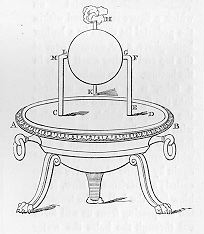Aeolipile illustration.png on:
[Wikipedia]
[Google]
[Amazon]
An aeolipile, aeolipyle, or eolipile, from the Greek "αιολουπυλη", also known as a Hero's engine, is a simple, bladeless radial turbine, radial steam turbine which spins when the central water container is heated. Torque is produced by steam jets exiting the turbine. The Greeks in Egypt, Greek-Egyptian mathematician and engineer Hero of Alexandria described the device in the 1st century CE, and many sources give him the credit for its invention. However, Vitruvius was the first to describe this appliance in his ''De architectura'' (ca. 30-20 BCE).
The aeolipile is considered to be the first recorded steam engine or reaction steam turbine, but it is neither a practical source of power nor a direct predecessor of the type of steam engine invented during the Industrial Revolution.
The name – derived from the Ancient Greek, Greek word Αἴολος and Latin word ''pila'' – translates to "the ball of Aeolus", Aeolus being the Greek mythology, Greek god of the air and wind.
 Both Hero and Vitruvius draw on the much earlier work by Ctesibius (285–222 BCE), also known as Ktēsíbios or Tesibius, who was an inventor and mathematician in Alexandria, Ptolemaic Kingdom, Ptolemaic Egypt. He wrote the first treatises on the science of compressed air and its uses in pumps.
Both Hero and Vitruvius draw on the much earlier work by Ctesibius (285–222 BCE), also known as Ktēsíbios or Tesibius, who was an inventor and mathematician in Alexandria, Ptolemaic Kingdom, Ptolemaic Egypt. He wrote the first treatises on the science of compressed air and its uses in pumps.
Physics
The aeolipile usually consists of a spherical or cylindrical vessel with oppositely bent or curved nozzles projecting outwards. It is designed to rotate on its axis. When the vessel is pressurised with steam, the gas is expelled out of the nozzles, which generates thrust due to the rocket engine, rocket principle as a consequence of the 2nd and 3rd of Newton's laws of motion. When the nozzles, pointing in different directions, produce forces along different lines of action perpendicular to the axis of the Bearing (mechanical), bearings, the thrusts combine to result in a rotational moment (mechanical Couple (mechanics), couple), or torque, causing the vessel to spin about its axis. Aerodynamic drag and frictional forces in the bearings build up quickly with increasing rotational speed (Revolutions per minute, rpm) and consume the accelerating torque, eventually cancelling it and achieving a steady state speed. Typically, and as Hero described the device, the water is heated in a simple boiler which forms part of a stand for the rotating vessel. Where this is the case, the boiler is connected to the rotating chamber by a pair of pipes that also serve as the wiktionary:Pivot, pivots for the chamber. Alternatively the rotating chamber may itself serve as the boiler, and this arrangement greatly simplifies the pivot/bearing arrangements, as they then do not need to pass steam. This can be seen in the illustration of a classroom model shown here.History
 Both Hero and Vitruvius draw on the much earlier work by Ctesibius (285–222 BCE), also known as Ktēsíbios or Tesibius, who was an inventor and mathematician in Alexandria, Ptolemaic Kingdom, Ptolemaic Egypt. He wrote the first treatises on the science of compressed air and its uses in pumps.
Both Hero and Vitruvius draw on the much earlier work by Ctesibius (285–222 BCE), also known as Ktēsíbios or Tesibius, who was an inventor and mathematician in Alexandria, Ptolemaic Kingdom, Ptolemaic Egypt. He wrote the first treatises on the science of compressed air and its uses in pumps.
Vitruvius's description
Vitruvius (c. 80 BCE – c. 15 BCE) mentions aeolipiles by name:Hero's description
Hero (c. 10–70 CE) takes a more practical approach, in that he gives instructions how to make one:Practical usage
It is not known whether the aeolipile was put to any practical use in ancient times, and if it was seen as a pragmatic device, a whimsical novelty, an object of reverence, or some other thing. A source described it as a mere curiosity for the ancient Greeks, or a "party trick". Hero's drawing shows a standalone device, and was presumably intended as a "temple wonder", like many of the other devices described in ''Pneumatica''. Vitruvius, on the other hand, mentions use of the aeolipile for demonstrating the physical properties of the weather. He describes them as: After describing the device's construction (see above) he concludes: In 1543, Blasco de Garay, a scientist and a captain in the Spanish navy, allegedly demonstrated before the Charles V, Holy Roman Emperor, Holy Roman Emperor, Charles V and a committee of high officials an invention he claimed could propel large ships in the absence of wind using an apparatus consisted of copper boiler and moving wheels on either side of the ship. This account was preserved by the royal Spanish archives at Simancas. It is proposed that de Garay used Hero's aeolipile and combined it with the technology used in Roman boats and late medieval galleys. Here, de Garay's invention introduced an innovation where the aeolipile had practical usage, which was to generate motion to the paddlewheels, demonstrating the feasibility of steam-driven boats. This claim was denied by Spanish authorities.Museo Naval, Catálogo guia del Museo Naval de Madrid, IX edición, Madrid, 1945, page 128.See also
*Catherine wheel (firework) *Rocket engine *Segner wheel *Steam engine * Steam locomotive *Steam rocket *Tip jetReferences
Further reading
*{{cite web , url=https://hackaday.com/2020/10/06/making-a-modern-version-of-a-steam-engine-from-antiquity/ , title=Making a Modern Version of a Steam Engine From Antiquity , first=Dan , last=Maloney , website=Hackaday , date=6 October 2020 , access-date=6 October 2020 , ref=none History of thermodynamics Steam engines Rocket engines Industrial design Hellenistic engineering Early rocketry Ancient inventions Ancient Egyptian technology Egyptian inventions History of technology